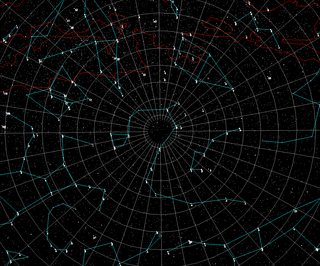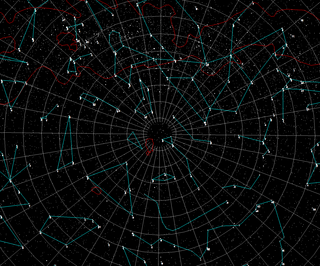Orbital pole
This articleneeds additional citations forverification.(January 2021) |

Anorbital poleis either point at the ends of theorbital normal,an imaginaryline segmentthat runs through afocusof anorbit(of a revolving body like aplanet,moonorsatellite) and isperpendicular(ornormal) to theorbital plane.Projected onto thecelestial sphere,orbital poles are similar in concept tocelestial poles,but are based on the body's orbit instead of itsequator.
Thenorthorbital pole of a revolving body is defined by theright-hand rule.If the fingers of the right hand are curved along thedirection of orbital motion,with the thumb extended and oriented to be parallel to the orbitalaxis,then the direction the thumb points is defined to be the orbital north.
The poles ofEarth's orbitare referred to as theeclipticpoles.For the remaining planets, the orbital pole inecliptic coordinatesis given by thelongitude of the ascending node(☊) andinclination(i):ℓ= ☊ − 90°,b= 90° −i.In the following table, the planetary orbit poles are given in both celestial coordinates and the ecliptic coordinates for the Earth.
| Object | ☊[1] | i[1] | Ecl.Lon. | Ecl.Lat. | RA (α) | Dec (δ) |
|---|---|---|---|---|---|---|
| Mercury | 48.331° | 7.005° | 318.331° | 82.995° | 18h43m57.1s | +61° 26′52″ |
| Venus | 76.678° | 3.395° | 346.678° | 86.605° | 18h32m01.8s | +65° 34′01″ |
| Earth | [a]140° | 0.0001° | [a]50° | 89.9999° | 18h00m00.0s | +66° 33′38.84″ |
| Mars | 49.562° | 1.850° | 319.562° | 88.150° | 18h13m29.7s | +65° 19′22″ |
| Ceres | 80.494° | 10.583° | 350.494° | 79.417° | 19h33m33.1s | +62° 50′57″ |
| Jupiter | 100.492° | 1.305° | 10.492° | 88.695° | 18h13m00.8s | +66° 45′53″ |
| Saturn | 113.643° | 2.485° | 23.643° | 87.515° | 18h23m46.8s | +67° 26′55″ |
| Uranus | 73.989° | 0.773° | 343.989° | 89.227° | 18h07m24.1s | +66° 20′12″ |
| Neptune | 131.794° | 1.768° | 41.794° | 88.232° | 18h13m54.1s | +67° 42′08″ |
| Pluto | 110.287° | 17.151° | 20.287° | 72.849° | 20h56m3.7s | +66° 32′31″ |
When a satellite orbits close to another large body, it can only maintain continuous observations in areas near its orbital poles. The continuous viewing zone (CVZ) of theHubble Space Telescopelies inside roughly 24° of Hubble's orbital poles, whichprecessaround the Earth's axis every 56 days.[2]
Ecliptic Pole
[edit]Theeclipticis the plane on whichEarth orbitstheSun.The ecliptic poles are the two points where the ecliptic axis, the imaginary lineperpendicularto the ecliptic,intersectsthecelestial sphere.
The two ecliptic poles are mapped below.
 The north ecliptic pole is inDraco. |
 The south ecliptic pole is inDorado. |
Due toaxial precession,eithercelestial polecompletes a circuit around the nearer ecliptic pole every 25,800 years.
As of 1 January 2000[update],the positions of the ecliptic poles expressed inequatorial coordinates,as a consequence of Earth'saxial tilt,are the following:
- North:right ascension18h0m0.0s(exact),declination+66° 33′ 38.55″
- South: right ascension6h0m0.0s(exact), declination −66° 33′ 38.55″
The North Ecliptic Pole is located near theCat's Eye Nebulaand the South Ecliptic Pole is located near theLarge Magellanic Cloud.
It is impossible anywhere on Earth for either ecliptic pole to be at thezenithin thenight sky.By definition, the ecliptic poles are located 90° from theSun's position.Therefore, whenever and wherever either ecliptic pole is directly overhead, the Sun must be on thehorizon.The ecliptic poles can contact the zenith only within theArcticandAntarcticcircles.
Thegalactic coordinatesof the North ecliptic pole can be calculated asℓ= 96.38°,b= 29.81°(seecelestial coordinate system).
See also
[edit]Notes & References
[edit]- ^abData from"HORIZONS Web-Interface".JPLSolar System Dynamics.NASA.Retrieved2020-09-01.Used "Ephemeris Type: Orbital Elements", "Time Span: discrete time=2451545", "Center: Sun (body center)", and selected each object's barycenter. Results are instantaneous osculating values at the precise J2000 epoch, and referenced to the ecliptic.
- ^"HST cycle 26 primer orbital constraints".HST User Documentation.hst-docs.stsci.edu.Retrieved2022-07-16.
